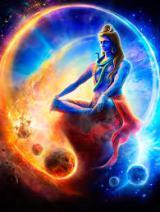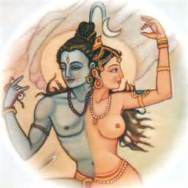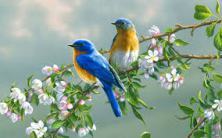Two Great Truths of Absolute and Relative Reality
In my volatile teens, I was struck by the poignant beauty of an ancient metaphor (contained within the Mundaka Upanishad) that speaks of two birds perched on the branch of a tree: one bird eats the fruit of the tree while the other watches.
The first bird represents the individual self/soul; distracted by the fruits (signifying sensual pleasures), she forgets her lord and lover and tries to enjoy the fruit independent of him. (This separating amnesia is known in Sanskrit as maha-maya or enthrallment; it results in the plunge of the individual into the ephemeral realm of birth and death.) As for the second bird, it is an aspect of the Divine/Self that rests in every heart—and which remains forever constant even as the individual soul is bedazzled by the material world.
This teaching implies that it is ignorance of our true nature that creates a vicious cycle: the individual, being blinded by the illusion of existing as a separate entity, has no option but to act—and therefore fresh misery is piled on the old. But the Absolute is whole and free of illusion; performing no actions it is not bound by karma.
In the grip of maya/illusion, the individual is subject to confused behavior (the classical definition of “karma” or “doing” is the movement of the mind and what it produces in terms of speech and action). Unable to put a halt to its own wretched trajectory, the individual soul passes through several kinds of wombs in accordance with its actions—but when it finally recognizes the other bird (the Divine) as its eternal Self, the veil of delusion is removed and bliss takes the place of sorrow.
Scholarly interpretations of this verse abound and you can investigate them quite easily. For me, however,it provided a golden key to understanding the link between Infinite Being and the finite self, helping me “see” both my inner world and my surroundings with fresh eyes.
 My own journey accelerated when, as a mutinous teen, I picked up a book from my father’s revolving rosewood bookcase—a green paperback with a yogi sitting motionless beneath a tree on the cover. Something both splendid and terrible arose within me at the sight of him, and I knew this would be the path I would choose to make sense of what then appeared to be a cruel and senseless world.
My own journey accelerated when, as a mutinous teen, I picked up a book from my father’s revolving rosewood bookcase—a green paperback with a yogi sitting motionless beneath a tree on the cover. Something both splendid and terrible arose within me at the sight of him, and I knew this would be the path I would choose to make sense of what then appeared to be a cruel and senseless world.
As the years flew past, I teetered between agnosticism and atheism, railing against a supposedly benevolent Creator God who could create a world rife with seemingly meaningless pain and confusion.
 Then, during my later years of study with the Mahayana Buddhists, I encountered The Two Truths: a metaphysical metaphor concerning the soul that first appears in Vedic scriptures (Rig Veda, Mundaka and Svetasvatara Upanisads). It was this powerful teaching that brought back to me the Upanishadic tale of the two birds: one representing the Relative, the other the Absolute.
Then, during my later years of study with the Mahayana Buddhists, I encountered The Two Truths: a metaphysical metaphor concerning the soul that first appears in Vedic scriptures (Rig Veda, Mundaka and Svetasvatara Upanisads). It was this powerful teaching that brought back to me the Upanishadic tale of the two birds: one representing the Relative, the other the Absolute.
Thanks to excellent gurus, I did not fall into the trap of using the Two Truths to create a true-false dichotomy, whereby the Absolute is true reality and the Reality is false reality; both Absolute and Relative Reality are truths. Secondly, Absolute and Relative are often described as different levels of reality—but the two are intertwined; seen through realized eyes, the two are an undivided whole.
The path up the mountain of pure consciousness can be a treacherous one and those who do not meticulously prepare for this most magnificent hike of all are liable to get lost. Each of us must discover for ourselves what needs to be done in order to realize the Self; since the goal is to know oneself as pure blissful consciousness, permanently free of desire and fear, blazing with light, the true seeker does whatever is necessary to scale this crystal mountain.
The quest deepens when we teach ourselves to distinguish between Real and Unreal (Absolute and Relative). The Real, according to Advaita, is that which does not come and go—and the only thing that fits this definition is our primal consciousness, and what precedes it: the Absolute Unmanifest.
 Today I am committed to the path to freedom that Ramana Maharshi revealed: Atma-Vichara/Self-Investigation/the Direct Path. Atma-Vichara is simple but not easy and the way I approach it hinges on the critical distinction made clear to me by both the Upanishadic metaphor as well as the Two Truths. As I walk this jewel-strewn way, I am grateful to those who cared enough to share their amazing insights with us.
Today I am committed to the path to freedom that Ramana Maharshi revealed: Atma-Vichara/Self-Investigation/the Direct Path. Atma-Vichara is simple but not easy and the way I approach it hinges on the critical distinction made clear to me by both the Upanishadic metaphor as well as the Two Truths. As I walk this jewel-strewn way, I am grateful to those who cared enough to share their amazing insights with us.
Greetings from Arunachala, the sacred mountain known to be the great God Shiva himself, and who helps the committed seeker destroy the Unreal so we can experience our Self as immortal bliss!
Follow Blog via Email
Enter your email address to follow this blog and receive notifications of new posts by email.
Click the buttons below to SHARE if you liked this post.








